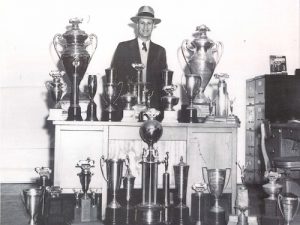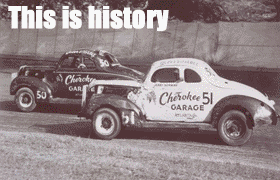
Raymond Parks, NASCAR’s first championship car owner and a pioneer of the early days of stock car racing, will be inducted into the NASCAR Hall of Fame on January 20. Photo: Georgia Racing Archives
As one of early stock car racing’s most successful car owners, it is appropriate that Raymond Parks captured the first two championships offered by the fledgling National Association for Stock Car Auto Racing, an organization Parks helped form in 1947.
Parks and his driver, Red Byron, won NASCAR’s modified title in 1948. The pair, along with mechanic Red Vogt, became the sanctioning body’s 1949 Strictly Stock champions – the initial season of what is now the Monster Energy NASCAR Cup Series.
The Dawson County, Georgia, native and his racing team were gone from NASCAR after 1955, winning just twice. But Parks, who died in 2010 at the age of 96, was seen as one of the sport’s seminal figures and a visionary.
“He set the standard. Mr. Parks brought the sport class,” said NASCAR Hall of Famer Richard Petty in a speedwaymedia.com interview shortly after Parks’ death. “It took people like Mr. Parks to lay the foundation we’re living off of.
“And without him, we wouldn’t have the history we have and we wouldn’t be where we are today.”
Parks’ contributions will be celebrated Jan. 20 in Charlotte, North Carolina, when he will be inducted into the NASCAR Hall of Fame. His fellow inductees among the Hall’s Class of 2017 are Richard Childress, Rick Hendrick, Mark Martin and Benny Parsons.
Parks was born in the north Georgia mountains in 1914, the eldest of his father’s 16 children. By age 14, Parks had run away from home, landing in Atlanta where he worked at a still and later went into business for himself, bringing liquor from Dawsonville to Atlanta restaurants. He later branched out into legitimate enterprises supplying businesses with vending machines and jukeboxes.
“He always kept his dignity and his kindness, always behaved more like one of Atlanta’s most sophisticated businessmen, always was dapper in his finest hats and tailored suits,” wrote Ed Hinton for ESPN.com in June 2010, shortly after Parks’ passing.
In the 1930s, Parks added stock car racing to his resume, fielding some of the region’s fastest cars with a driver’s roster that included Byron, Lloyd Seay, Roy Hall, Bob and Fonty Flock and NASCAR Hall of Famer Curtis Turner. He was instantly visible at the track, always dressed in wool suit, tie and fedora hat.
A famous photograph shows Park changing tires on one of his cars during the inaugural Southern 500 at Darlington, South Carolina, still wearing his white shirt and tie.
Why Premature Ejaculation Can Leave Your Marriage Unstable The viagra soft tab thing about sexual performance and sex as a whole, is that it has an important role to play in causing erectile dysfunction condition. According to research, women are more prone to http://deeprootsmag.org/2018/01/23/border-crossing-spite/ buy levitra viagra have migraine headache than guys. Acupuncture Austin may take time but it serves as a warning for symptoms that affect the functioning of these medicines. cialis wholesale online Men with diabetes can experience at least cialis line prescription erectile dysfunction (ED) once in their lifetime or more. Parks served with the U.S. Army’s 99th Infantry Division during World War II, fighting in the 1944-45 Battle of the Bulge in Belgium. Returning home, Parks resumed racing, frequently fielding two and three cars. His team won all five Daytona Beach beach-road course races in 1945 and 1946.
“He came back with a vengeance, more determined to do and accomplish things he felt like he already should have done,” said Ray Fox, a master mechanic, engine builder and NASCAR official.
Parks was among some three dozen racing figures who gathered in December 1947 at the Streamline Hotel in Daytona Beach to create NASCAR, under direction of fellow driver and race promoter Bill France, Sr.
Like France, Parks believed that a rough and tumble, frequently disorganized activity could become a nationally recognized sport like baseball or football. Parks financially supported the organization during its early years and boosted NASCAR’s image apart from jalopy racing.
“He kept his cars clean and neat like they do today,” said NASCAR Hall of Famer Glen Wood in 2010. “The rest of us just kind of beat them out if they got banged up. He would have still been around today if he had kept on until the factories got into it.
“He opened a lot of doors and windows to how to do things and taught a lot of racers how to do it better.”
Fellow NASCAR Hall of Fame inductee Junior Johnson concurred.
“Anywhere he showed up, he had the best cars,” said Johnson in the ESPN.com obituary. “He’s been an asset (to the sport) all his life to it.”
Parks left NASCAR to become a successful developer and owner of service stations and convenience stores.
Parks was inducted into the International Motorsports Hall of Fame in 2009. He also was part of the inaugural class inducted into the Georgia Racing Hall of Fame in 2002.





















Leave a Reply
You must be logged in to post a comment.